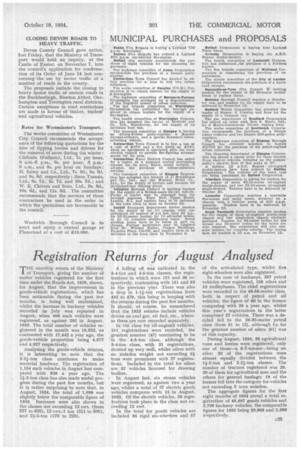Registration Returns for August Analysed
Page 47

If you've noticed an error in this article please click here to report it so we can fix it.
THE monthly return of the Ministry of Transport, giving the number of motor vehicles registered for the first time under the Roads Act, 1920, shows, for August, that the improvement in goods-vehicle registrations, which has been noticeable during the past few months, is being well maintained, whilst the increase in hackney vehicles recorded in July was repeated in August, when 408 such vehicles were registered, as against 292 in August, 1933. The total number of vehicles regis,tered in the month was 19,523, as contrasted with 17,442 a year ago, the .goods-vehicle proportion being 4,577 and 4,027 respectively.
Analysing the goods-vehicle returns, it is interesting to note that the 2-2k-ton class continues to make material headway. The registration of 1,154 such vehicles in August last compared with 828 a year ago. The 1i-2-ton class has also made useful progress during the past few months, but it is rather surprising to note that, in August, 1934, the total of 1,098 was slightly below the comparable figure of 1933, Increases were also shown in . the classes not exceeding 12 cwt. (from 577 to 638), 12 cwt.-1 ton (511 to 560), and 21-3-ton (170 to 229). A falling off was indicated in the 3-4-ton and 4-5-ton classes, the registrations in which were 121 and 36 respectively, contrasting with 161 and 83 in the previous year. There was also a drop in 1-1i-ton registrations from 492 to 470, this being in keeping with the returns during the past few months. It should, of course, be remembered that the 1933 returns include vehicles driven on coal gas, oil fuel, etc., whereas these are now recorded separately.
In the class for oil-engined vehicles, 151 registrations were recorded, the greatest number (47) continuing to be in the 4-5-ton class, although the 3-4-ton class, with 31 registrations, showed up very well, whilst oilers with an unladen weight not exceeding 2i tons were prominent with 27 registrations. Included in the total for oilers are 32 vehicles licensed for drawing trailers.
In August last, six steam vehicles were registered, as against two a year ago, whilst a total of 37 electric goods vehicles compares with 15 in August, 1933, Of the electric vehicles, 26 registrations took place in the class not exceeding 12 cwt.
In the total for goods vehicles are included 85 rigid six-whealers and 57 of the articulated type, whilst five eight-wheelers were also registered. In the case of hackneys, 287 petrol vehicles were registered, 108 oilers and 13 trolleybuses. The chief registrations were recorded in the 48-56-seater class, both in respect of petrol and oil vehicles, the figure of 66 in the former comparing with 26 a year ago, whilst this year's registrations in the latter comprised 27 vehicles. There was a decided fall in the 26-32-seater petrol class (from 51 to 12), although by_ far the greatest number of oilers (61) was of this capacity.
During August, 1934, 56 agricultural vans and lorries were registered, only one of them—a 6-7-tonner—being an oiler; 32 of the . registrations were almost equally divided between the 14-2-ton and 2-21-ton classes. The number of tractors registered was 29, 20 of them for agricultural uses and the others for general haulage; 19 of the former fell into the category for vehicles not exceeding 5 tons unladen.
The aggregate figures for the first eight months of 1934 reveal a total registration of 45,697 goods vehicles and 0,739 hackney vehicles, the comparable figures for 1933 being 33,808 and 2,900 respectively.












































































































